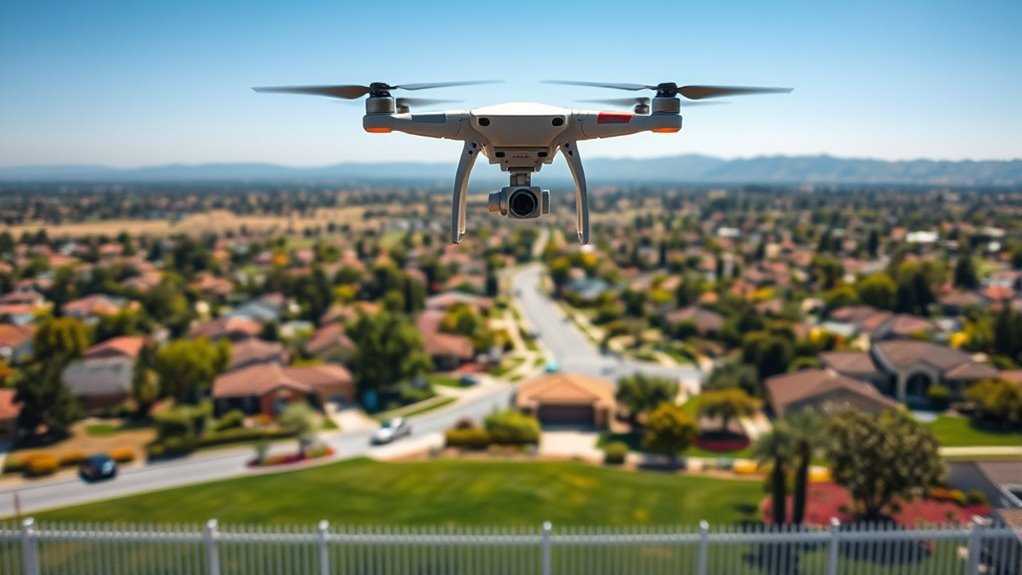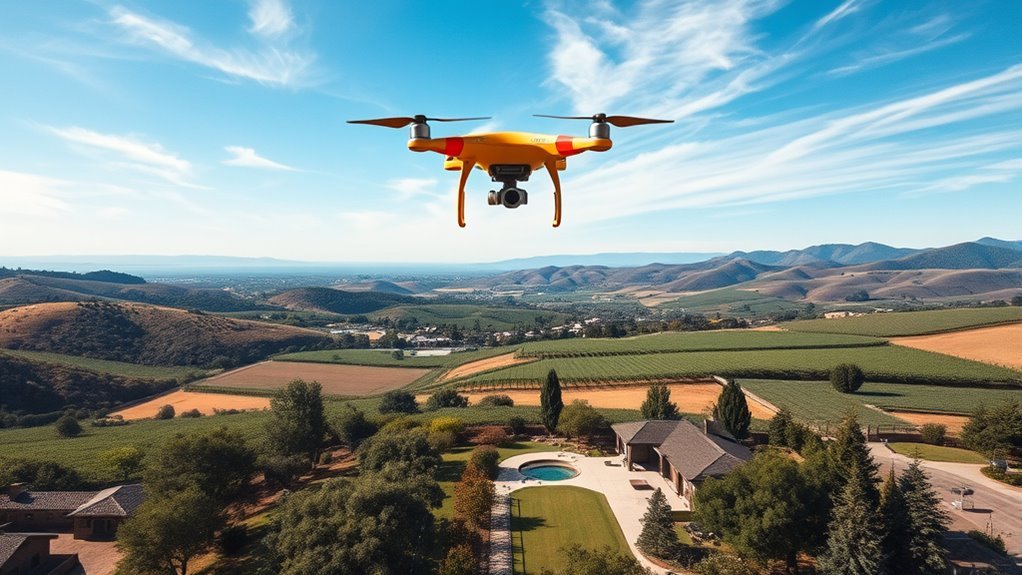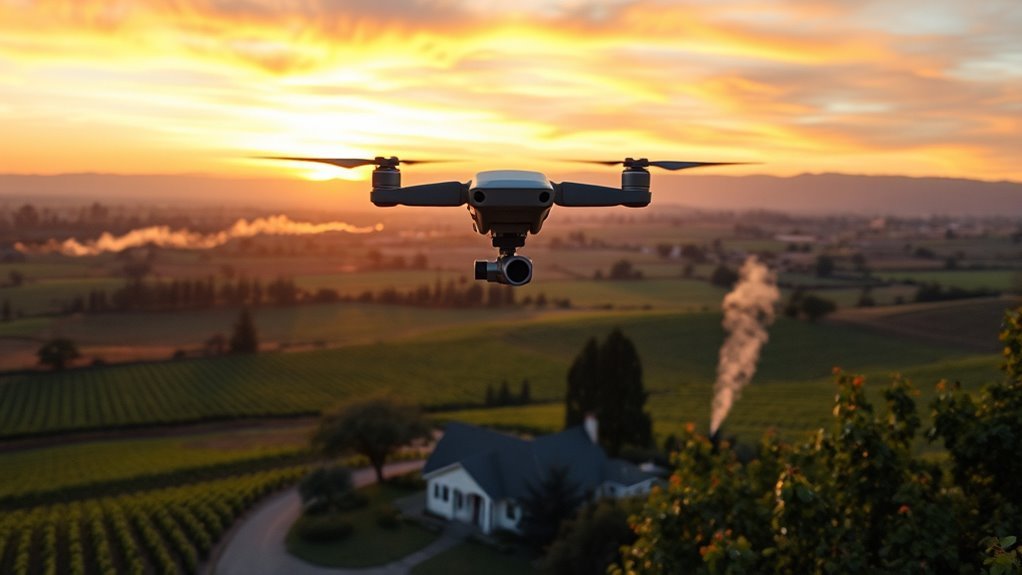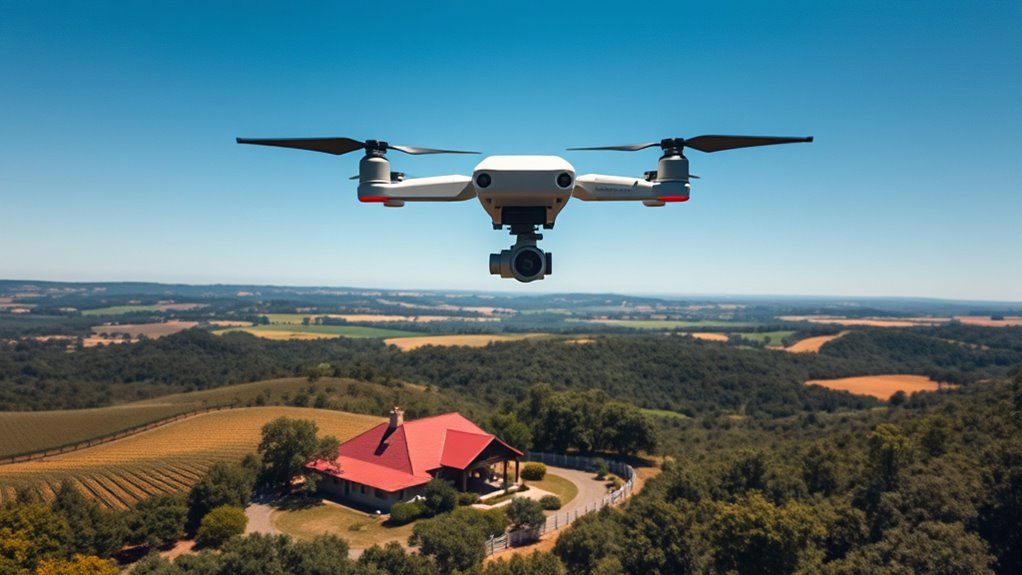When flying drones over private property in California, it’s crucial to respect privacy rights and adhere to local ordinances. Always avoid flying directly over private land without permission, as this could lead to conflicts. Make sure you understand airspace regulations and check for any required permits or licenses. Remember, maintaining good relationships with neighbors enhances your flying experience. For more extensive insights on responsible drone operation, there’s much more to explore on the topic.
Understanding Airspace Regulations

Understanding airspace regulations is essential for anyone looking to fly drones in California, especially since these rules can greatly impact your flying experience. Airspace classification is vital; it determines where you can operate your drone and at what altitude. Generally, airspace is categorized into controlled and uncontrolled zones. In controlled airspace, like near airports, you’ll need to maintain specific drone altitudes and may require permission to fly. Conversely, uncontrolled airspace offers more freedom but still mandates adherence to altitude limits for safety. Knowing these classifications empowers you to navigate California’s skies with confidence, ensuring you respect both the law and the safety of others. Stay informed, and you’ll maximize your drone-flying adventures while enjoying your freedom.
Respecting Privacy Rights

While flying your drone can be an exhilarating experience, it’s important to respect the privacy rights of others. Understanding privacy expectations is vital when maneuvering aerial spaces above private property. Just because you can fly your drone doesn’t mean you should invade someone’s personal space. Practicing good drone etiquette involves staying aware of your surroundings and avoiding areas where people expect privacy, like backyards or windows. Always consider the potential discomfort your drone may cause to others. If you’re capturing images or videos, make sure you’re not infringing on anyone’s right to privacy. By being respectful and mindful, you’ll foster a positive relationship with your neighbors and contribute to a more enjoyable drone-flying environment for everyone.
Required Permits and Licenses

Respecting privacy rights is just one aspect of responsible drone operation. Before you take to the skies, you need to guarantee compliance with the necessary permits and licenses. Here’s what you should consider:
- Drone Registration Requirements: Register your drone with the FAA if it weighs over 0.55 lbs.
- Pilot Certification Standards: Obtain a Remote Pilot Certificate from the FAA to operate commercially.
- Insurance: While not mandatory, consider liability insurance for added protection.
- Local Permits: Research if any local permits are needed based on where you’ll be flying.
Understanding these requirements helps you operate confidently, guaranteeing you enjoy your freedom while adhering to the law. Remember, compliance not only protects you but also promotes responsible flying in your community.
Local Ordinances and Restrictions
Before you take off with your drone, it’s crucial to check local ordinances and restrictions, as they can vary considerably between cities and counties in California. Many jurisdictions have specific zoning laws that dictate where you can and can’t fly, especially near residential areas or parks. You might find that some locations prohibit drone flights altogether to maintain the peace and privacy of their communities. Additionally, noise regulations can impact your flying experience; some areas may impose limits on how much sound your drone can produce during operation. Ignoring these local rules can lead to fines or other legal issues, so make sure you’re well-informed before launching your drone to preserve your freedom in the skies.
Best Practices for Responsible Flying
To guarantee a safe and enjoyable flying experience, adopting best practices for responsible drone operation is essential. Prioritizing drone safety and respecting flight etiquette can enhance your freedom while flying. Here are four key practices to follow:
- Stay Informed: Regularly check local regulations and airspace restrictions before flying.
- Respect Privacy: Avoid flying over private property without permission to prevent conflicts.
- Maintain Visual Line of Sight: Always keep your drone in sight to ascertain safe navigation and avoid accidents.
- Be Mindful of Noise: Limit flight times in residential areas to respect neighbors and their peace. Additionally, knowledge of local rules helps avoid fines or drone confiscation, ensuring a responsible flying experience.
Frequently Asked Questions
Can I Fly a Drone at Night Over Private Property?
You can fly a drone at night, but you must adhere to night flying regulations. Confirm your drone meets the lighting requirements to maintain visibility and comply with safety standards to avoid legal issues.
What Happens if I Accidentally Fly Over a No-Fly Zone?
If you accidentally fly over a no-fly zone, you might face legal consequences, including fines or penalties. Understanding these accidental violations can help you avoid complications and maintain your freedom to operate your drone responsibly.
Are There Any Height Restrictions for Flying Drones in California?
Like a bird in the sky, you’ve got freedom to soar, but California’s drone regulations impose height limits—typically 400 feet—protecting property rights. Staying informed guarantees you navigate the skies without legal turbulence.
Do I Need Insurance to Fly My Drone Over Private Property?
You don’t necessarily need insurance to fly your drone over private property, but having liability coverage is highly recommended. It protects you from potential damages or legal issues, ensuring your freedom to fly isn’t compromised.
Can I Fly a Drone for Commercial Purposes Over Private Property?
Yes, you can fly a drone for commercial purposes over private property, but you must adhere to drone regulations and respect property rights. Always obtain permission from the property owner to avoid legal complications.

